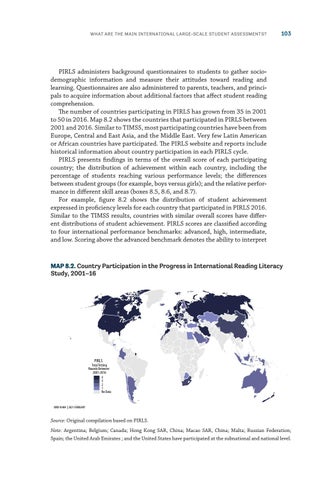What Are the Main International Large-Scale Student Assessments?
103
PIRLS administers background questionnaires to students to gather sociodemographic information and measure their attitudes toward reading and learning. Questionnaires are also administered to parents, teachers, and principals to acquire information about additional factors that affect student reading comprehension. The number of countries participating in PIRLS has grown from 35 in 2001 to 50 in 2016. Map 8.2 shows the countries that participated in PIRLS between 2001 and 2016. Similar to TIMSS, most participating countries have been from Europe, Central and East Asia, and the Middle East. Very few Latin American or African countries have participated. The PIRLS website and reports include historical information about country participation in each PIRLS cycle. PIRLS presents findings in terms of the overall score of each participating country; the distribution of achievement within each country, including the percentage of students reaching various performance levels; the differences between student groups (for example, boys versus girls); and the relative performance in different skill areas (boxes 8.5, 8.6, and 8.7). For example, figure 8.2 shows the distribution of student achievement expressed in proficiency levels for each country that participated in PIRLS 2016. Similar to the TIMSS results, countries with similar overall scores have different distributions of student achievement. PIRLS scores are classified according to four international performance benchmarks: advanced, high, intermediate, and low. Scoring above the advanced benchmark denotes the ability to interpret
MAP 8.2. Country Participation in the Progress in International Reading Literacy Study, 2001–16
PIRLS
Total Testing Rounds Between: 2001-2016 4 3 2 1 No Data
IBRD 45404 | 2021 FEBRUARY
Source: Original compilation based on PIRLS. Note: Argentina; Belgium; Canada; Hong Kong SAR, China; Macao SAR, China; Malta; Russian Federation; Spain; the United Arab Emirates ; and the United States have participated at the subnational and national level.

